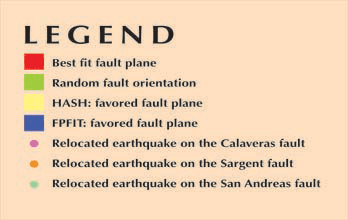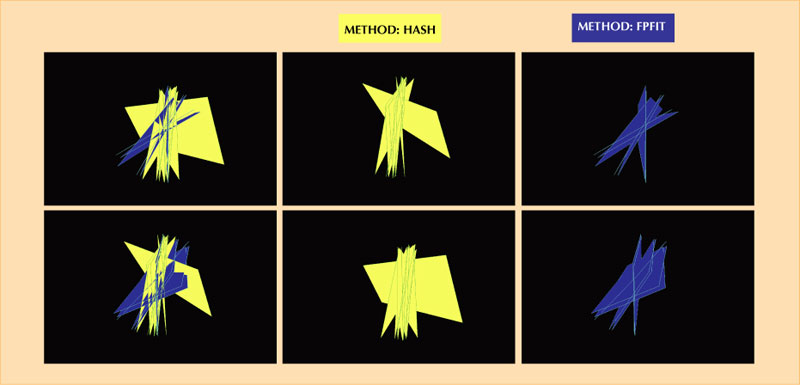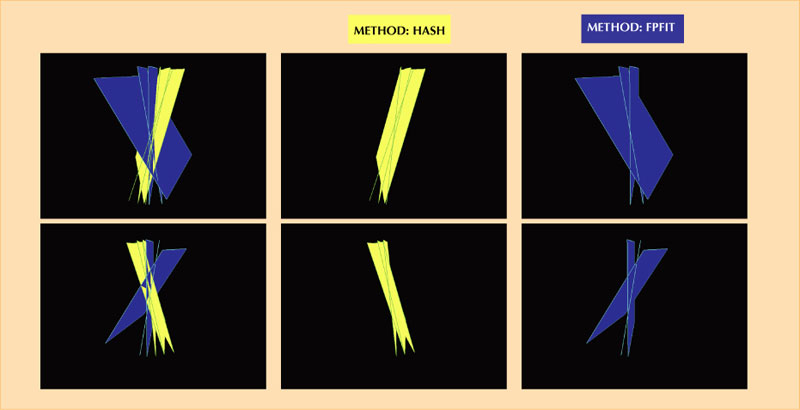Electronic Supplement to
Fault Parameter Constraints Using Relocated Earthquakes: A Validation of First Motion Focal Mechanism Data
by Debi Kilb and Jeanne Hardebeck
3-D Interactive Visualization
Requires the iView3D Freeware that runs on many popular platforms (e.g., Mac OSX, Windows, Linux, Solaris, SGI). More information is available on the iView3D product page at the IVS 3D website.
Often exploring 3-D data interactively allows the viewer to gain a better understanding of the correlations across data sets and assess the variability of the data within both small and large scale regions. Additionally, the ability to toggle on/off different data sets from view can greatly enhance the overall understanding of the data. The interactive 3-D visualization (Visualization V1) we provide here includes: best fit fault planes (red), randomly oriented fault planes (green), fault planes derived using the HASH software (yellow), fault planes derived using the FPFIT software (blue), relocated data on the Calderas fault (pink), relocated data on the Sargent fault (orange), and relocated data on the San Andreas fault (green).
Visualization V1: 3-D interactive Visualization
Download: Kilb_Hardebeck.v8.scene.zip. [~2.9 MB zipped iView3D scene file.]
Download: iView3D. [Link to external website form. Free registration required.]

QuickTime Movies: 3-D flight Through the Data
Requires Apple's free QuickTime software, available for recent versions of Mac OS and Microsoft Windows. A standalone QuickTime installer for Windows 2000/XP or Mac OS (version 10.3.9 or newer) can be downloaded here.
The 3-dimensional nature of focal mechanism data, in combination with the spatial variability of seismicity in our study region, makes it difficult to compare and contrast data from different catalogs and assess nuances between adjacent earthquakes. To better understand these data, we have created QuickTime movies of the 3-D visualization V1 that include data from: The Calderas fault (Movie M1), the Sargent fault (Movie M2), and the San Andreas Fault (Movie M3). You can request higher resolution versions of these movies from vizinfo@ucsd.edu.
Movie M1: Data from the Calderas fault
Download/View: Calaveras_BSSA.mov [~4.8 MB QuickTime movie file].
Movie M2: Data from the Sargent fault
Download/View: Sargent_BSSA.mov [~4.5 MB QuickTime movie file].
Movie M3: Data from the San Andreas fault
Download/View: SAF_BSSA.mov [~6.6 MB QuickTime movie file].
Testing the Robustness of the FPFIT and HASH Mechanisms Using Repeating Earthquakes
We use clusters of repeating earthquakes to gauge the accuracy of the cataloged earthquake focal mechanisms. Repeating earthquakes, by definition, rupture identically oriented fault planes, and so our expectation is that each of the focal mechanisms in a repeating cluster should be identical or very similar. In general, we find the HASH mechanisms exhibit much more similarity with each other than the NCEDC/FPFIT mechanisms. Since the waveforms of these earthquakes are virtually identical at each station, implying identical focal mechanisms, this suggests the HASH catalog is more reliable.
Repeating cluster on the Calaveras Fault
Repeating Cluster of Earthquakes on the Calaveras Fault Located at Approximately: -121.24°, 36.63°, 4.1 km depth. Of the two possible nodal planes we choose the plane most consistent with the general trend of seismicity in the region. The HASH mechanisms exhibit much more similarity* with each other than the NCEDC/FPFIT mechanisms. Since the waveforms of these earthquakes are virtually identical at each station, implying identical focal mechanisms, this suggests the HASH catalog is more reliable.

